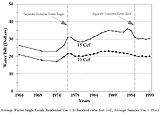
| ch. 5, pp. 53 - 55 |
Many people will conserve water if the price is very high. The point at which people will respond to higher bills varies greatly, depending mostly on personal income and the percentage of total household expense the water bill represents. Some people may find a $100 water bill acceptable while others may have problems paying a fourth as much. Water rates can be modified to encourage conservation in two very different ways:
Changing Rate Structures Tucson’s first water rates in 1900 were flat rates, as are some of Salt River Project’s rates today. A flat rate means people pay the same for water no matter how much they use. For many years, Winterhaven had a flat rate for water, with the expectation that people would maintain lush lawns and landscapes, although this has changed and desert landscapes are now acceptable in that Tucson neighborhood. Today almost all communities nationally meter water usage and thus charge people more for increased water use. Water bills from all water providers in the Tucson area have two basic parts — a basic rate determined by the size of the connection (this is a fixed charge applied whether or not water is used) and a commodity rate which is charged for every unit of water used over a minimum amount. For many water providers, the minimum amount is 2,000 gallons. Some water companies charge a higher commodity rate for water use above certain amounts (referred to as an increasing block rate or progressive rate structure). This type of rate structure is designed to discourage high-volume water use. Tucson Water, Metro Water and Avra Water Co-op have increasing block rates. Another water rate structure variation designed to encourage water conservation is seasonal water rates. Seasonal rates usually involve charging a higher commodity rate during summer months than during winter months. Higher summer rates are designed to encourage more conservation when more water is needed to meet peak demand on the water system. Metro Water has had seasonal rates since 1995. Tucson Water had seasonal rates for all customer classes from 1977 to 1995 but removed seasonal rates for the single family residential and duplex-triplex classes in 1995. Water rates are an important signal about the relative scarcity of water and the need to conserve. If rates do not keep up with inflation, the real price of water actually declines. People may take that as a signal that water is cheap and conservation is not important. Even if the real price of water is held constant, incomes in Pima County have increased at a faster rate than inflation. This is good news for the economy, but means that water bills shrink as a relative share of the overall budget. The incentive to conserve is reduced.
Tucson Water has pursued a water rate policy designed to lower peak demand and encourage water conservation. Tucson Water instituted increasing block rates and seasonal rates as a conscious effort to discourage excessive water use. Especially after the 1975-76 water controversy (S Chapter 2), many Tucson Water customers saw significant increases in their water bills, and water use decreased significantly as the message to conserve hit home. At this time the water conservation program, Beat the Peak, was initiated. As is shown in Figure 5-10, between 1976 and 1993 rates were updated every year. For average water use customers, bills just barely kept ahead of inflation. At least in part because the real price of water stayed about the same, and incomes in County increased at a higher rate than the rate of inflation, water use increased. In 1993, there was a significant increase in the price of water, especially the summer rate. Public reaction, however, forced a redesign of the rates and a decline in the real price of water in the summer. The real (inflation adjusted) price of water has declined since then. Water providers must get approval to change water rates. Municipal water utilities must get approval from the city or town council. Changing the rates is much more difficult for water companies that must get approval from the Arizona Corporation Commission (). Going through this process is expensive because of the legal fees involved and costs of a rate hearing can easily reach hundreds of thousands of dollars, even for a small water company. This is required even if a company doesn’t plan to raise more revenue from customers, but just change the rate structure. This discourages many companies from changing rate structures to promote conservation.
Charging More to Pay For Future Supplies A more controversial way to change rates is to charge more in anticipation of the need to acquire a more expensive water supply in the future. The cost of developing and delivering Tucson’s new water supplies — CAP and treated effluent — are more expensive than pumping and delivering groundwater. Some economists argue that people now using the cheaper water should help pay for the future costs of developing the new, more costly supplies that eventually will be needed. According to this theory water costs should rise to build up a reserve for the future. This would make it fairer for future users who must use the more costly water, and the higher cost would encourage conservation of the existing supply. This approach is rarely adopted for many reasons. For one, it is not a politically popular approach. Also, it is virtually impossible for a private water company to acquire extra money to cover future costs through the ACC process. Municipal utilities are often run on a cost of service basis, neither making a profit nor running a deficit. Accumulation of an unused pot of money would not fit this model, although some funds can be put aside for the future.
|


